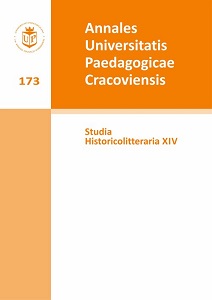Znaczenia i sposoby kształtowania przestrzeni w opowieściach biograficznych o artystach Anny Czerwińskiej-Rydel
Meanings and Ways of Creating Space in Biographical Stories about Artists by Anna Czerwińska-Rydel
Author(s): Krystyna ZabawaSubject(s): Studies of Literature, Polish Literature, Theory of Literature
Published by: Wydawnictwo Uniwersytetu Komisji Edukacji Narodowej w Krakowie
Keywords: children’s literature; space in literature; biographical story; place in literature; locus amoenus; non-place; narrator-character; observer; motif of the road;
Summary/Abstract: The subject of the article is the category of space (spatial forms) in biographical books for young readers by Anna Czerwińska-Rydel: Jaśnie Pan Pichon. Rzecz o Fryderyku Chopinie, Fotel czasu (about Aleksander Fredro) and W podróży ze skrzypcami. Opowieść o Henryku Wieniawskim. These stories are placed in a strong contemporary tendency to write artists’ biographies. They took similar motifs and story arcs (e.g. travel topos). Every analyzed story contains descriptions of happy places, especially ones connected with childhood. The author analyzes them in the context of ancient topos of locus amoenus. In turn, the element of every artist’s fate, that is leaving home and traveling, can be explained by using the idea of a nonplace (described by M. Augé). It is an anonymous space, alienating and causing loneliness. The last part of the article is devoted to a special literary means that is coexistence of two spacetime plans: the XIX century and contemporary one. One of the consequences of the look to the past and famous artists’ lives from the perspective of XXI-century teenagers is a new social space appearing in the stories: Internet.
Journal: Annales Universitatis Paedagogicae Cracoviensis. Studia Historicolitteraria
- Issue Year: 2014
- Issue No: 14
- Page Range: 225-238
- Page Count: 14
- Language: Polish

